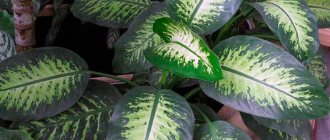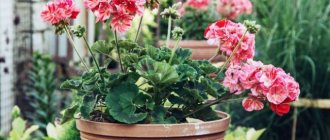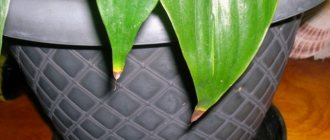Spraying is an important procedure for caring for many types of indoor plants. In order for moistening the stems and leaves to bring maximum benefit, you need to know how, with what and at what time it is best to produce it. The frequency of spraying may depend on the air temperature, season of the year and stage of flower development. It is undesirable to moisten the leaves of some plants due to the peculiarities of their structure; water getting on the inflorescences can lead to a deterioration in their appearance and rapid falling.
Why spray indoor plants?
Spraying plants is used to humidify the air, fertilize, clean leaves from dust, spray solutions that destroy infectious agents and harmful insects.
Water is necessary for the synthesis of organic substances that make up all above-ground and underground parts of the plant. Their formation occurs in leaf cells that absorb solar energy and carbon dioxide. The main amount of water involved in these reactions enters the stems from the roots, which absorb moisture from the soil. But it can also be absorbed directly by the surface of the leaves themselves. Therefore, spraying the bush increases the formation of proteins, accelerates the development of the plant and improves its appearance and immunity.
In addition, water procedures perform a number of other additional, no less important functions:
- Humidify the air. This brings great benefits to plants in high temperatures and dry indoor conditions. The stems and leaves consist of 70% water; in hot weather, its intense evaporation leads to a deterioration in the condition of indoor flowers. High air humidity is typical for the natural habitat of tropical species, where it often reaches 90%, so they develop worse in the normal microclimate of living rooms.
- Clean the above-ground parts of the bush from dust. Leaf contamination interferes with the absorption of solar energy and active plant growth. It is necessary to periodically wash off settling dust particles even from cacti that are accustomed to drought and indoor flowers with densely pubescent leaves. At the same time, it is important to protect the soil from waterlogging and ensure that immediately after the procedure the plants are kept in a dark and warm place until the stems and leaf blades are completely dry.
- Provides nutrients. Microelements included in organic or mineral fertilizers are often applied not only by watering at the root, but also by spraying the solution.
- Destroy pathogens and harmful insects. A stream of ordinary water can wash away pests that have settled on the surface of the bush, having previously protected the soil from them with a film. Solutions of drugs for treating fungal and bacterial diseases, as well as killing insects, are especially effective when sprayed over the entire surface of the plant. If necessary, they are repeated at certain time intervals.
Mixing drugs is prohibited
With the exception of multicomponent preparations that are mixed before use, you should not combine different products for indoor plants. Even fertilizing cannot be carried out simultaneously with treatment with insecticides or fungicides. What can we say about mixing these drugs with each other! Treatments with different chemicals need to be “spaced out” over time, leaving sufficient pauses to observe how the plant feels and how a particular drug acts.
Which plants need spraying?
Cyperus, guzmania and palm trees are plants that require regular spraying
Most houseplants benefit from misting.
They are especially important for species with dense, leathery or large, rosette-forming leaves. Such indoor flowers evaporate a lot of moisture and need high air humidity, especially in the summer or heating season at temperatures above 20°C.
Regular spraying is necessary:
- tropical plants, for example, calathea, aglaonema, anthurium, orchid;
- coniferous species, in particular cypress and araucaria;
- citrus fruits - lemon, tangerine, grapefruit;
- plants with delicate flowers, for example azaleas, brunfelsia, anthurium, gardenia, but it is advisable to protect the petals from water;
- ferns, ficus;
- bromeliads - Aechmea, Nidularium, Neoregelia, which under natural conditions absorb water that falls into funnels from the leaves during rain.
Causes of aphids
The parasite can get on home flowers in various ways:
- A winged female flew through an open window in the room.
- Delivered by a pet or a person on clothing. The larvae stick very well to people's clothing and animal fur.
- I was on a recently acquired plant, from which I quickly moved to others.
- Larvae were present in the mixture used for planting.
- They brought it along with flowers that stood outside, on the balcony or loggia in warm weather.
- They brought in ants that feed on the excess juice produced by this pest.
Which plants should not be sprayed?
Succulents can easily withstand dry air thanks to the moisture reserves in their thick stems and spines, which shield the genus from overheating from the bright rays of the sun.
Some species not only do not need spraying, but can also be damaged if drops of water get on the stems and leaves. These include plants that naturally grow in countries with arid climates, as well as those with thin and tender leaves, with a jagged edge along the edge or having a fleecy or wrinkled surface.
Flowers that do not require spraying include:
- geranium, caladium, begonia, pelargonium (leaves are thin and tender);
- saintpaulia, gloxinia, gray peperomia (pubescent foliage);
- streptocarpus, coleus, calceolaria (wrinkled leaves);
- cacti, aloe, crassula and many other types of succulents with thickened stems and leaves.
When spraying any plants during the flowering period, avoid getting water on the flowers. When wet, the petals stick together and soon wither.
In fruit-bearing species, moisture washes away pollen, which reduces the likelihood of flower pollination. Densely pubescent or wrinkled leaf surfaces slow down water absorption and evaporation. At low air temperatures, they can begin to rot; when exposed to sunlight, a burn appears in the place where moisture accumulates.
Streptocarpus and other flowers with wrinkled leaf surfaces are not sprayed.
However, all these plants need to increase air humidity and remove dust from the leaves. To do this, just place a container of water or a room humidifier near the bushes. You can clean the leaves with a soft brush or by taking a warm shower once a month.
The procedure is carried out in the evening, moving the flower pot to a shaded place and returning it to the window after it has completely dried. Before spraying, the soil under the cacti is allowed to dry thoroughly or the soil is covered with film. When using a sprayer with very small holes, the amount of water flowing down the stem is significantly reduced.
How to spray indoor plants correctly
It is convenient to spray plants in the bathroom, covering the soil with film or foil.
The frequency of spraying depends on the time of year and room temperature. The procedure must be performed following a number of rules:
- Moisten the bushes on hot days in the morning and evening, when the plant is not in direct sunlight. At the same time, they must have time to dry before sunset, since the wet surface of the leaves increases the risk of developing fungal diseases, and the process of photosynthesis stops with the onset of dusk.
- Spraying is carried out after watering the flowers, otherwise, with the reverse sequence of procedures, it will be difficult to determine from the surface of the soil whether the soil is watered or only moistened by droplets falling from the leaves.
- The leaves should be moistened on both sides, since it is on the lower surface of the leaf blade that the stomata are located, through which water penetrates the cells. In addition, this prevents the plant from being damaged by spider mites, which prefer to reproduce in a dry environment.
- For spraying, use a spray bottle that creates tiny drops of water. In this case, they will be able to linger for a while around the leaves in the air, and not immediately flow down, waterlogging the soil.
- Moistening is stopped after drops of water begin to roll off the leaves.
- During winter, most plants go dormant in a cool room. The lower the air temperature, the slower the moisture evaporates and the less frequently the bushes are sprayed. Conversely, when it increases, there is a need for more frequent watering and spraying water around the bushes.
When spraying, both sides of the leaf should be moistened.
If the room temperature is below +16°C, spraying should be stopped or reduced to a minimum, since cold and high humidity create favorable conditions for the proliferation of fungi and putrefactive bacteria. Also, do not spray moisture on plants located on a cool windowsill.
Guseva Ulyana
Ask a Question
Question to the expert
Is it possible to spray orchids and how to do it correctly?
Spraying is necessary for good growth and development of orchids. Sometimes dry indoor air is the reason for the plant not to bloom. The frequency of spraying depends on the room temperature. At 22–25°C, it is enough to carry out the procedure several times a week; at higher values, you can humidify the air around the plant more often; at lower values, it is better to refrain from spraying water. The flowers should not be allowed to get wet; to protect them from drops, it is convenient to cover them with a plastic bag. Moistened leaves and roots should not be exposed to direct sunlight to avoid burns. When fertilizing, it is recommended to use solutions with a low concentration of fertilizers for spraying.
The effectiveness of the drug depends on the accuracy of following the instructions
When using fertilizers and growth stimulants (and especially insecticides and fungicides), more is not better. Each drug undergoes lengthy tests and inspections, during which its properties are studied. And if you do not follow the instructions on proportions, concentration, method of application, you should not count on the full manifestation of the expected properties.
Strengthened mixtures may not harm the plant. But the damage to the environment, health and pets is very difficult to measure. Reduced concentrations are no better: drugs that are not used within the effective recommended solutions can simply be wasted.
If the indicated proportions suggest too much product for your plant, then a proportional reduction in the amount of water and the drug is quite acceptable. But make sure that unused leftover medications can be stored after opening or dispose of them immediately.
Plants must be sprayed with insecticides and fungicides separately.
How to spray water for spraying
The quality of spraying depends on the size of the sprayed droplets. A simple sprayer that supplies water by pressing the handle of a hand pump has several modes of operation, but the particles of water that fly out of the holes are quite large and uneven. More modern models allow you to create a fine mist that lingers in the air much longer. When it gets on the leaves, its drops are quickly absorbed, and the residues easily evaporate without causing increased humidity on the shoots of plants.
It should be taken into account that when caring for indoor flowers, both spraying methods are used:
- A fine spray of water in the form of a mist is suitable for daily increasing the air humidity around the bush.
- Spraying larger drops is required for foliar feeding with fertilizer solutions and removing dirt and dust from the surface of leaves.
Description of aphids
Aphids are small insects with an elongated body and long legs. Its belly is quite wide with a pointed end. The color varies: pale, greenish, pinkish, pale yellow, black. The most common aphid is white. All types cause the same harm. The insect sucks the sap of plants by piercing the leaves. Feels great in any environment and adapts well. Reproductive function is well developed.
Species differ in color and the presence of wings. The winged one searches for and captures new habitats, and the wingless one reproduces. Each female lays about 100 larvae, which after 2 weeks become adults. Most often they can be found on young shoots and buds, and on the leaves - on the inside.
What can you use for spraying?
The spraying liquid is selected depending on the purpose of the treatment. Simple tap, well, river or well water is used after preliminary settling, boiling, filtration, distillation or freezing and subsequent thawing. These manipulations allow you to get rid of chlorine, mineral salts and other harmful substances contained in the water.
If back in the middle or at the end of the last century it was recommended to use rain or moisture obtained after thawing snow for plants, now it may contain particles of chemicals.
Therefore, precipitation should be collected and used carefully, for example, at the end of rain or snowfall, or taking into account the environmental situation in the place of residence.
The temperature of the liquid should be room temperature or slightly higher. In summer, in hot weather, cooler water can be used to improve the microclimate around the flower.
To repel pests and destroy pathogenic infections, plants are sprayed with various folk remedies, in particular tobacco infusion, solutions of mustard powder, potassium permanganate, laundry or tar soap, and wood ash.
The following solutions and infusions are also used for spraying:
- Decoctions of various herbs - chamomile, celandine, onion peels, mustard, garlic, citrus peels, yarrow, potato tops, pine needles, wormwood, hot pepper - to increase resistance to diseases, repel pests, inhibit the activity of bacteria and fungi when affected by infections.
- Solutions of baking soda and soda ash, wood ash, sulfur, laundry soap and alcohol, tar soap and kerosene, potassium permanganate, vegetable oil and washing powder as folk remedies for exterminating insect pests. If these substances do not help, proceed to the use of insecticides of chemical origin.
- Insecticide solutions. They are obtained by diluting a concentrated emulsion, granular or powdered preparations, following the manufacturer’s instructions.
- Fertilizer solutions. These can be substances of organic origin - compost, humus, wood ash, herbal infusions. To prepare solutions of mineral fertilizers, nitrogen, phosphorus, potassium, as well as complex compositions are used, including a balanced amount of all necessary microelements.
- Preparations for the destruction of bacteria and fungi in the treatment of infectious diseases.
How to properly carry out foliar feeding
Plants are fed not only when watering, but also in a foliar way, by spraying a nutrient solution on the leaves.
Fertilizers can be applied to plants not only by deepening dry substances into the soil, but also in a wet state when watering or spraying. When spraying nutrient solutions on leaves, it is important to follow these rules:
- For plants with large leaves, the frequency of fertilizing should not exceed 1 time every 3 weeks; for other species, it is enough to carry out the procedure once a month.
- Fertilizer application at the root and by spraying should not be carried out simultaneously. It is recommended that the interval between them be 10 days or more.
- Before feeding, you should clean the leaves from dust by spraying with clean water or wiping with a damp rag.
- Flowering plants do not need foliar fertilization.
- The first half of the day is suitable for spraying with nutrient solutions; this allows indoor flowers to better absorb the micro- and macroelements falling on the leaves.
Separate storage
All chemicals, including fertilizers, must be stored separately, avoiding any proximity not only to food, but also to medicines, household chemicals, herbal supplies, etc.
The storage area for indoor plant chemicals should be cool and dark, out of reach of children and animals. It is worth periodically inspecting the integrity of the packaging and paying attention to storage dates.
Products that have expired should not be disposed of with household waste, but following the instructions for products of their safety class according to the manufacturer’s instructions.
How often can you spray indoor flowers?
Representatives of tropical and subtropical forests in the warm season need regular spraying in the morning and evening.
The frequency of spraying depends primarily on the air temperature and the preferences of the plant itself. In a warm or hot room, species that tolerate leaf moisture well can be sprayed more than twice a day, provided that at this moment direct rays of the sun do not fall on them. As the temperature decreases, the need for air humidification decreases. If its values do not exceed 20°C, water from the surface of the leaves evaporates much more slowly, so the risk of damage to indoor flowers by putrefactive bacteria and fungal infections increases.
During the dormant period, when the plant is in a cool room, the frequency of spraying is reduced or stopped completely. But, when it is not possible to provide flowers with such conditions, spraying water will help them more safely withstand the lack of seasonal temperature fluctuations and dry air due to the operation of heating devices.
Question to the expert
Often, light spots appear on the surface of the leaves of my ficus and calathea after spraying. I water the flowers in the morning and evening, when they are not exposed to bright sunlight. If the possibility of a burn is excluded, what could be causing the appearance of such spots?
Most likely, salts are deposited on the leaves. To remove them, the water should be left for 24 hours at room temperature. There are other ways to reduce its hardness: boil it, pass it through a filter or distiller.
Cleaning with utmost care
After all work with the plants is completed, do not forget to tidy up the work area. Remains of leaves and drops of solutions must be removed immediately, if possible, not forgetting to wet clean all surfaces that the working solutions could touch. But the main attention should be paid to dishes, containers and tools. Just rinsing them with water is not enough: thoroughly wash all used tools with clean water and a mild detergent. Ventilation is a mandatory step after working with chemicals indoors.
What problems may arise as a result of spraying?
The leaves of plants exposed to the bright rays of the sun often get burned when sprayed during the day.
Sometimes, failure to follow simple spraying rules leads to defects on flowers and leaves or a deterioration in the condition of plants. The most common problems that arise are:
- The formation of yellow or light brown spots on the leaves as a result of sunburn. To prevent this from happening, spraying should be done early in the morning or late in the evening. At this time, the sun is low above the horizon and its rays are less active.
- The appearance of light spots due to the high salt content in the water. Soft water is used for spraying, since if the concentration of mineral substances is exceeded, after the leaves dry, white spots remain on them, which not only spoil the appearance of the plant, but also interfere with the normal course of the photosynthesis process.
- Rotting or scorching of plants with thin, pubescent or wrinkled leaves. These species do not need to be sprayed, since water from the surface of such leaf blades evaporates slowly. Because of this, drops of moisture when exposed to sunlight act like lenses, leading to burns, and in cloudy weather bacteria multiply in them, causing tissue rotting.
- The appearance of unsightly spots on the petals, wilting and falling of flowers. Blooming specimens should be sprayed very carefully. To protect the flowers from moisture, you can cover them with a cellophane bag.
- Plant disease is a fungal infection, the most dangerous of which is root rot. This can be facilitated by spraying the bush at low air temperatures, as well as waterlogging of the soil, which occurs when excessively abundant watering is followed by sprayed water getting onto the substrate. The danger of rapid proliferation of fungi also increases with frequent water treatments for flowers located in a room with high air humidity (for example, in a greenhouse, indoor greenhouse).
- Deterioration of plant development and growth. It is observed when cold water is used for spraying and watering. Plants experience temperature shock, moisture is poorly absorbed by roots and leaves, as a result they look weak, lethargic and may begin to rot.
Air humidity is very important for the development of indoor flowers. Its optimal value for most species is 60...70%. Spraying is used as one of the most effective ways to increase it. In addition, spraying solutions allows you to supply plants with nutrients, cool them in hot weather, and fight diseases and pests. To obtain droplets of the very desired size, special sprayers with adjustable nozzles are used.











